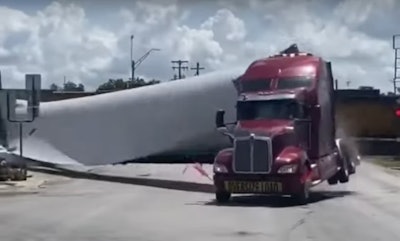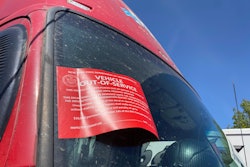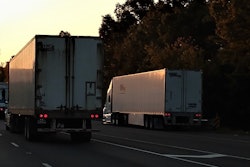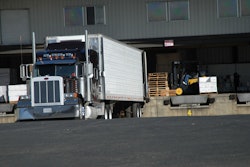
The National Highway Traffic Safety Administration's plan to mandate side underride guards may represent one of the costliest trucking mandates of all time. It's being carried out in the name of improved safety, but many in trucking contend it could have the exact opposite impact by leading to disaster on rail crossings.
NHTSA's Advance Notice of Proposed Rulemaking from April, which gathered more than 2,000 comments on the Federal Register, makes it clear that when the agency talks about mandating side underride guards, it has no idea how that would impact operational safety for commercial truck drivers.
"NHTSA did not take into consideration the practicability and feasibility of side underride guards on trailer and semitrailer operations," the ANPRM reads.
Operational concerns abound. For example, a broad coalition of rail and port associations asked for an exemption for intermodal chassis, which are commonly stacked -- something underride guards would prevent.
But perhaps the most serious safety concerns had to do with questions of ground clearance at rail crossings.
[Related: Driver arrested after crash derails train in Tennessee]
"Could side underride guards scrape or snag on the road surface when the trailer travels over humped surfaces like some rail crossings, or when the truck backs into a steep loading dock ramp?" asks NHTSA's ANPRM. "Could movement of the trailer then be disabled, damaging the guards and necessitating replacement?"

In short, the answer to these questions is likely yes, big time.
The Owner-Operator Independent Drivers Association, in comments filed the Federal Register, certainly thinks so.
"OOIDA has notably heard from drivers about the dangers of traversing highway-rail crossings with side underrides attached to their trailers," the organization wrote. "In 2022, there were more than 2,000 highway-rail crossing collisions in the U.S. and more than 30,000 reports of blocked crossings submitted to the Federal Railroad Administration’s public complaint portal."
A comment from trucker Patrick Newbill on the regulatory docket gets to the heart of the issue: "We already have a hard enough time backing up into steep docks, going over rail crossings, and making sharp turns. Things are not set up to accommodate underride guards. They will just cause more trailer and property damage."
Flatbedder Norman Lassen explained in his comment how the mandate would impact his operation with dangerous "unintended consequences."
"As a flatbed owner I will be forced to put my dunnage, V boards, ladders and other equipment I currently store under the trailer between the frame rails, out of sight," he said. Storing it all on top of the trailer "will reduce the loading space on the trailer, and will invite theft. Not to mention the added weight on a truck that needs the lightest weight possible to serve my customers."
Lassen added he felt "the guards will cause more truck-train collisions, as they will high-center trucks on sloped crossings even more that what happens now."
The Truck and Trailer Manufacturers Association also sided with drivers opposed to the mandate. "TTMA believes that adoption of current SUG designs will necessarily increase incidents of trailers getting hung up at railway crossings," the organization wrote in its comment to NHTSA. That "would increase risk of death and injury at these crossings. Again, the magnitude of this risk is hard to quantify accurately, but also could be greater than any benefit."
[Related: Ohio, Arizona hazmat disasters hold lessons for owner in the fight against safety complacency]
With a spate of recent, high-profile train derailments, any disregard of the potential for rail disasters raises the question of liability. What happens if a truck with a government-mandated side underride guard gets caught on a rail crossing, intersection, ramp, or hill? As Newbill emphasized, existing roads were not built with side underride guards in mind, and OOIDA feels liability would ultimately fall to the carrier and/or its driver.
"In these situations," the OOIDA wrote, "due to sovereign immunity at the federal and state level for claims relating to negligent roadway design and construction, motor carriers will be unable to recover damage costs sustained from underride equipment on poorly designed or constructed areas of the current infrastructure."
Motor carriers, the OOIDA said, could "find themselves facing liability for damage caused by underride equipment. Both of these scenarios require the motor carrier, or its insurer if the policy provides applicable coverage, to bear the cost of resulting damage."
Add to that the costs of installing and maintaining the guards, the increased fuel consumption the 400-800-pound devices would cause, the ways guards might hamper pre- and post-trip inspections, the increased wear and tear on trailer bodies and the potential for damage to the low-hanging rails to cause downtime and violations for drivers ... The list of liabilities the mandate poses to trailer owners and pullers, in short, is long.
It's worth nothing that NHTSA's own most-recent analysis does not assert that the benefits of such a mandate would outweigh the costs.
In fact, as previously reported, it's quite the opposite, with the ANPRM noted the mandate could cost the trucking world about $73 million for each life saved annually. They get that number by dividing the projected costs, about a billion dollars, by the projected lives saved: 17.
 This is the Low Ground Clearance sign displayed at some rail crossings. Notice anything missing? Bridges on the highway often mark their height, but have you ever seen that ahead of a rail crossing?
This is the Low Ground Clearance sign displayed at some rail crossings. Notice anything missing? Bridges on the highway often mark their height, but have you ever seen that ahead of a rail crossing?
In trucking, when the going gets tough, the tough get going. If the mandate does come to pass, hardworking carriers and drivers might find a way to overcome the obstacles, including high rail crossings. Yet there is next to no clear way to know if your trailer can clear a rail crossing or curb. The Federal Railroad Administration does not provide information on clearance heights on the nation's highway-rail grade crossings, nor is it aware of any publicly available source for such information.
The FRA does provide some general information on navigating rail crossings, but contends that the duty of calculating the clearance falls solely on the driver. A Low Clearance Vehicle Railroad Crossing PSA similarly does not include specifics on how to assess if your vehicle can cross a hump. The organization has looked into using drone-based photography and measurement to get readings on rail crossings, but nothing has come of it as of yet.
The FRA indicated it had been in touch with NHTSA on the lowering of trailer clearances that the side underride mandate would require.
In current practice, ultimately the responsibility to avoid trailers getting stuck on rail crossings falls on truck drivers, with little in the way of assistance from signage or other sources of information.










